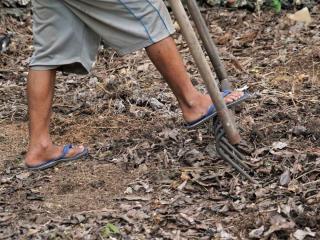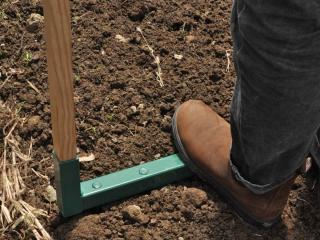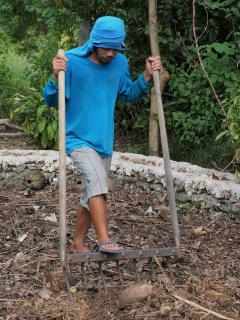

A standout tool in permaculture, the broadfork is an eco-friendly tool, also known as a grelinette, bio-fork, aerator fork, or aerator. It allows for deep soil loosening without disrupting soil balance… and without straining your back!
This tool, equipped with two handles and 3 to 9 tines, was invented in 1963 by Mr. Grelin, a French seed merchant from Chambéry. It certainly has a cost for such a simple tool. Is in this amazing tool worth the cost?
The broadfork is a gardening tool that replaces the spade, spade-fork, beaked spade, and even the rototiller. It is an eco-friendly fork, or a bio-fork, consisting of several elements:
 Two wooden or metal handles.
Two wooden or metal handles.The original model created by André Grelin and his son had 5 tines and was 16 inches wide (40 cm). A broadfork is a particularly ergonomic tool, to the point that it earned its inventor first prize at the Lépine Innovation competition in 1963.
The broadfork replaces the spade or spade-fork effectively to aerate, work and loosen the soil.
However, these two tools are quite different. Whereas a spade, and to a lesser extent the spade-fork, turns the soil upside-down, a broadfork loosens soil but does not turn it.
As a result, using a broadfork does not disrupt or disturb the microorganisms present in the soil. Keeping these tiny critters alive is very useful for enriching soil through their work. Indeed, many microorganisms, bacteria, fungi, small fauna… inhabit soil. Some are anaerobic; others are aerobic and, with the spade, both types die as they no longer find themselves in their element. Not to mention earthworms and larger insects living in soil that contribute by breaking down organic materials.

 Place the broadfork upright in the soil, one hand on each handle, shoulder-level
Place the broadfork upright in the soil, one hand on each handle, shoulder-levelThere is no need to bend over to use the broadfork. Your back should stay straight during the entire cycle, which eases work. Similarly, bending down by pulling the handles towards you is counterproductive. Again, the gardener should stand straight.
Depending on its intended use, the broadfork can be used in fall, before adding manure or covering the soil, or at the end of winter and at the start of spring to prepare soil before sowing and planting.
Note that it is recommended to rake surface mulch away before using the broadfork.
The broadfork is the perfect tool for light soil that has already been worked. However, for very heavy, clay or really waterlogged soils, it’s not the ideal tool.
This is particularly true in fall, when the soil is very heavy because of the rain. In fact, in heavy soil, in fall, it’s better to dig it out. Then, frost will break clods, and come spring, the broadfork can take over in a drained soil (2 or 3 days after rain). Likewise, if you want to create a vegetable garden in a wild field or in a lawn, the broadfork won’t be enough.
Its price remains an obstacle: you expect at least 100$ (90 euros or pounds) for a good quality broadfork. This is clearly much higher a price than that of a spade. But the investment is long-term and above all, preserves your back while protecting soil inhabitants.